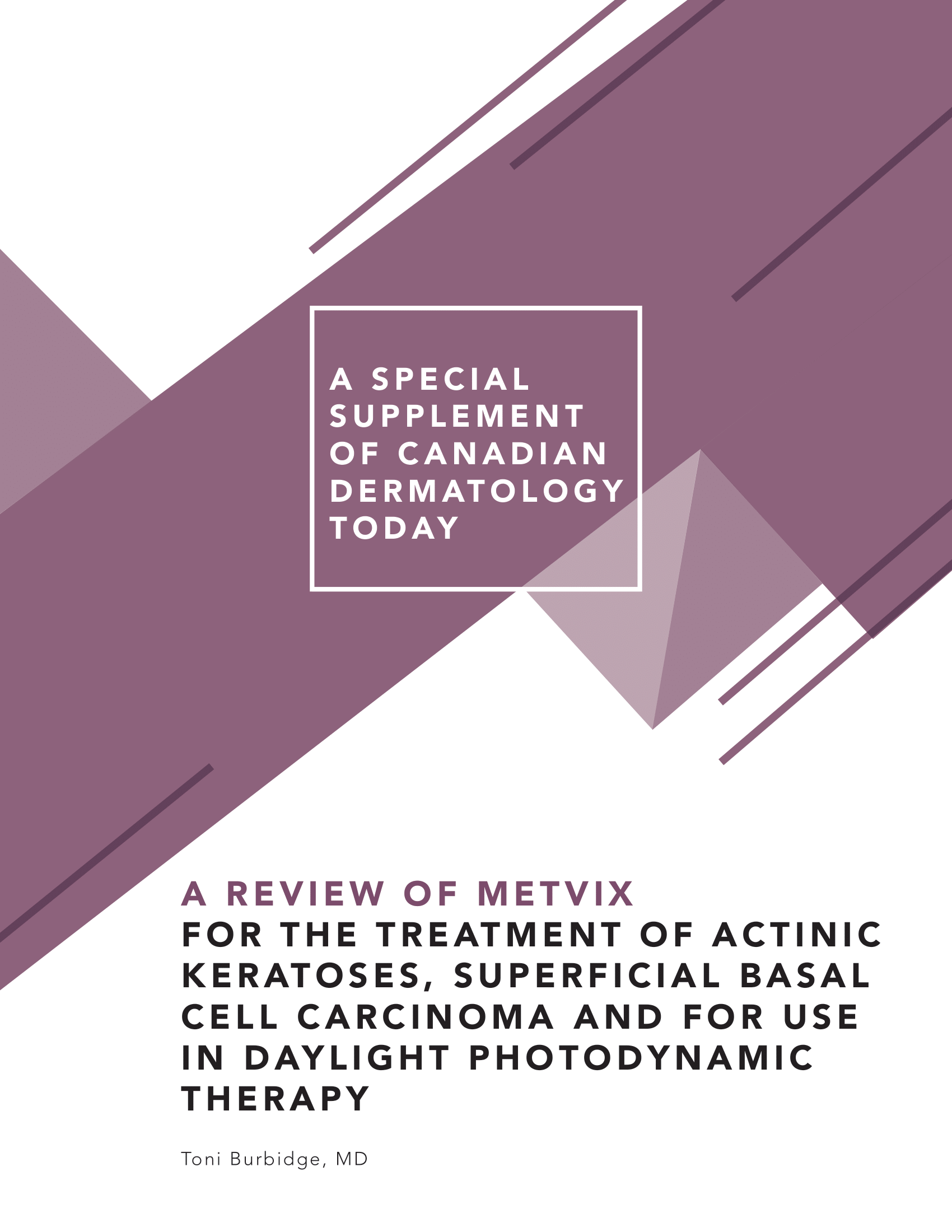A review of Metvix for the treatment of actinic keratoses, superficial basal cell carcinoma and for use in daylight photodynamic therapy
Abstract
With increasing sun exposure and an aging population, skin malignancies dysplasia are becoming more prevalent. This includes premalignant actinic keratoses (AK), basal cell carcinoma (BCC), squamous cell carcinoma (SCC), and other skin cancers. Many treatment options are available for these conditions, including cryotherapy, surgery, topical field therapy creams, and photodynamic therapy (PDT).
PDT utilizes a photosensitizing agent and visible light in the presence of oxygen to produce reactive oxygen species (ROS), which then induce apoptosis of cellular components leading to cell death. Conventional PDT (c-PDT) is approved in Canada for the treatment of non-hyperkeratotic actinic keratoses (AK) and superficial basal cell carcinoma (BCC) outside the H-zone of the face. It is also used off label for the treatment of squamous cell carcinoma in-situ (SCCis), which is an approved indication for PDT in many European countries. Daylight PDT (d-PDT) using methyl aminolaevulinate (MAL) for AK is also approved by Health Canada. In Canada, there are two approved topical photosensitizers: Levulan® Kerastick (5-Aminolevulinic acid or 5-ALA) (DUSA Pharmaceuticals Inc) and Metvix (MAL) (Galderma Canada Inc). Only Metvix is approved for the treatment of AK, superficial BCC and for the use in daylight PDT in Canada, and as such it is the focus of this article.
References
Henderson BW, Dougherty TJ. How does photodynamic therapy work?. Photochem Photobiol. 1992;55(1):145-157. doi:10.1111/j.1751-1097.1992.tb04222.x
Galderma Canada Inc. Metvix (methyl aminolevulinate topical cream) [product monograph]. Health Canada website. https://pdf.hres.ca/dpd_pm/00038693.PDF . Revised March 30, 2017. Accessed September 9, 2022.
Clarion Medical Technologies Inc. Levulan Kerastick [product monograph]. Health Canada website. https://pdf.hres.ca/dpd_pm/00027478.PDF. Revised September 30, 2014. Accessed September 9, 2022.
Morton CA, Szeimies RM, Basset-Seguin N, et al. European Dermatology Forum guidelines on topical photodynamic therapy 2019 Part 1: treatment delivery and established indications – actinic keratoses, Bowen’s disease and basal cell carcinomas. J Eur Acad Dermatol Venereol. 2019;33(12):2225-2238.
Rigel DS. Cutaneous ultraviolet exposure and its relationship to the development of skin cancer. J Am Acad Dermatol. 2008;58(5):S129-32.
Eisen DB, Asgari MM, Bennett DD et al. Guidelines of care for the management of actinic keratosis. J Am Acad Dermatol. 2021 Oct 1;85(4):e209-33.
Peris K, Fargnoli MC, Garbe C, et al. Diagnosis and treatment of basal cell carcinoma: European consensus-based interdisciplinary guidelines. Eur J Cancer. 2019;118:10-34.
Cameron MC, Lee E, Hibler BP, et al. Basal cell carcinoma: Contemporary approaches to diagnosis, treatment, and prevention [published correction appears in J Am Acad Dermatol. 2019 Jul;81(1):310]. J Am Acad Dermatol. 2019;80(2):321-339.
Ibbotson SH, Wong TH, Morton CA, et al. Adverse effects of topical photodynamic therapy: a consensus review and approach to management. Br J Dermatol. 2019;180(4):715-729.
Pastor-Nieto MA, Olivares M, Sánchez-Herreros C, Belmar P, De Eusebio E. Occupational allergic contact dermatitis from methyl aminolevulinate. Dermatitis. 2011;22(4):216-219.
Rubel DM, Spelman L, Murrell DF, et al. Daylight photodynamic therapy with methyl aminolevulinate cream as a convenient, similarly effective, nearly painless alternative to conventional photodynamic therapy in actinic keratosis treatment: a randomized controlled trial. Br J Dermatol. 2014;171(5):1164-1171.
Vignion-Dewalle AS, Baert G, Thecua E, Vicentini C, Mortier L, Mordon S. Photodynamic therapy for actinic keratosis: Is the European consensus protocol for daylight PDT superior to conventional protocol for Aktilite CL 128 PDT?. J Photochem Photobiol B. 2017;174:70-77.
Dirschka T, Radny P, Dominicus R, et al. Long-term (6 and 12 months) follow-up of two prospective, randomized, controlled phase III trials of photodynamic therapy with BF-200 ALA and methyl aminolaevulinate for the treatment of actinic keratosis. Br J Dermatol. 2013;168(4):825-836.
Basset-Seguin N, Ibbotson SH, Emtestam L, et al. Topical methyl aminolaevulinate photodynamic therapy versus cryotherapy for superficial basal cell carcinoma: a 5 year randomized trial. Eur J Dermatol. 2008;18(5):547-553.
Photodynamic Therapy | Memorial Sloan Kettering Cancer Center. www.mskcc.org. Accessed November 7, 2022. https://www.mskcc.org/cancer-care/patient-education/photodynamic-therapy


